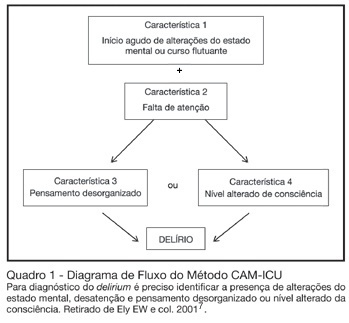Abstract
Rev Bras Ter Intensiva. 2010;22(3):274-279
DOI 10.1590/S0103-507X2010000300010
Delirium is an acute confusional state associated with increased mortality in the intensive care unit and long-term impaired functional recovery. Despite its elevated incidence and major impact in the outcomes of critically ill patients, delirium remains under-diagnosed. Presently, there are validated instruments to diagnose and monitor delirium, allowing the detection of early organ dysfunction and treatment initiation. Beyond patient's non-modifiable risk factors, there are modifiable clinical and environmental aspects that should be accessed to reduce the occurrence and severity of delirium. As recent studies demonstrate that interventions aiming to reduce sedative exposure and to improve patients' orientation associated with early mobility have proved to reduce delirium, a low incidence of delirium should be targeted and considered as a measure of quality of care in the intensive care unit (ICU).
Abstract
Rev Bras Ter Intensiva. 2009;21(1):58-64
DOI 10.1590/S0103-507X2009000100009
Delirium is frequently observed in intensive care unit patients and its occurrence is related to increased morbidity and mortality, length of stay, functional decline and high costs. The Confusion Assessment Method for Intensive Care Unit is a tool that facilitates early identification and occurrence of delirium among intubated patients. Objective: To verify the aspects of delirium studied by means of the Confusion Assessment Method for Intensive Care Unit. A literature review was conducted in the LILACS, MedLine, PubMed and CINAHL databases, from 2001, when the Confusion Assessment Method for Intensive Care Unit was validated, to 2008. Descriptors used for LILACS, MedLine and PubMed were delirium and intensive care unit, while for the CINAHL database, delirium and intensive care were used. From 293 articles, 35 were selected. The aspects analyzed disclosed, different types of delirium in different intensive care units. Variation in sensitivity was of 93% to 100% and variation in specificity, 89% to 100% of the Confusion Assessment Method for Intensive Care Unit, an important tool for detection, characterization and control of delirium and its impact. The aspects of delirium studied by means of the Confusion Assessment Method for Intensive Care Unit were: the performance index, identification, management, cost of treatment, morbidity and mortality due to delirium.

Abstract
Rev Bras Ter Intensiva. 2006;18(2):190-195
DOI 10.1590/S0103-507X2006000200013
BACKGROUND AND OBJECTIVES: Delirium is a frequent finding in the critically ill patient. Although it is associated with increased morbidity and mortality, it is often not recognized by intensive care doctors. This review will address the main issues regarding delirium in critically ill patients. CONTENTS: Definition, incidence, mortality, risk factors, diagnosis, and treatment of delirium in the critically ill. CONCLUSIONS: Deliriumis defined as a disturbance of consciousness, attention, cognition and perception that occurs frequently in critically ill patients. It occurs in as many as 80% of mechanically ventilated ICU patients. Risk factors for delirium include acute systemic illnesses, older age, pre-existing cognitive impairment, sleep deprivation, and medications with anticholinergic activity. Although new assessment tools are available for rapidly and accurately measuring deliriumin critically ill patients, healthcare professionals still do not regularly monitor for this condition. In recent years, the emphasis in the approach to delirium has shifted to systematic screening and prevention. Haloperidol remains the standard treatment for delirium, but there is some evidence for the efficacy of risperidone.
